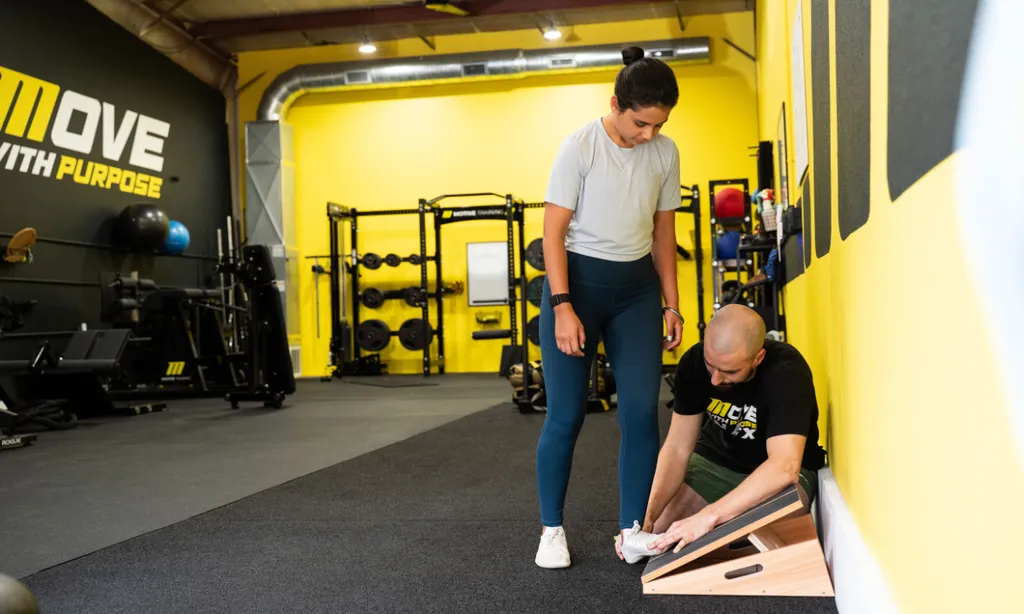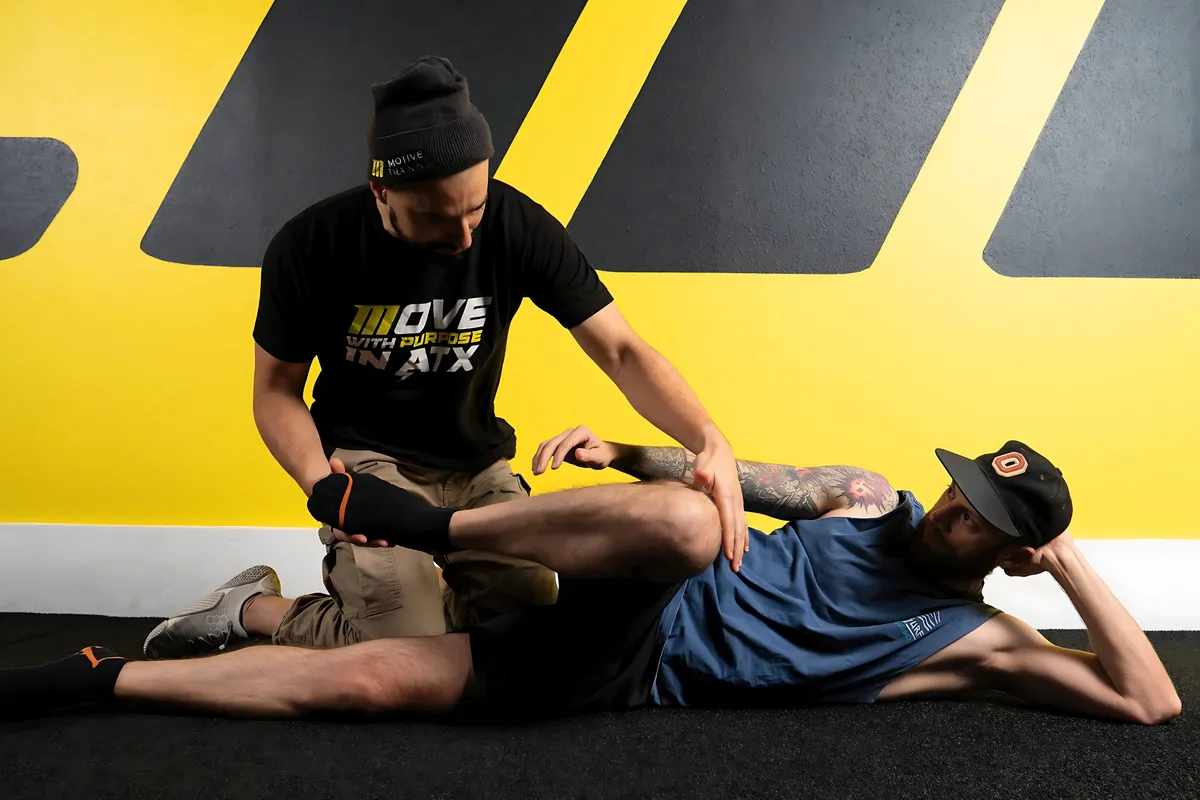FRC vs Static Stretching: The Mobility Difference Austin Clients Notice
November 5, 2025 | Functional Range Conditioning

Most people think stretching is enough to stay mobile and pain-free. They bend, hold, and breathe through tension, hoping it’ll make their bodies move better. But flexibility isn’t the same as mobility—and that difference determines whether you actually improve or just maintain the status quo.
At Motive Training in Austin, we teach a different approach: Functional Range Conditioning, or FRC®. It’s a system that transforms how your joints move, how your muscles support them, and how your body handles real-world stress.
Let’s break down why FRC creates lasting change while traditional stretching often falls short.
Static Stretching: The Comfort Zone That Doesn’t Stick
Static stretching is what most people grew up with—hold a muscle for 30 seconds, feel a pull, repeat. It can feel good in the moment because it relaxes the nervous system and temporarily reduces muscle tone. But once you stand up and start moving, that new range of motion fades.
That’s because static stretching doesn’t teach your body how to control the new range. It’s like opening a door wider without reinforcing the hinges. You gain space, but you don’t gain stability.
Research has shown that while static stretching can increase temporary flexibility, it rarely improves movement quality or strength through that range. For active people—or anyone managing pain—it’s not enough.
Functional Range Conditioning: Strength Inside Every Inch of Motion
FRC takes a different approach. It focuses on training the tissues around each joint to actively control movement. Instead of forcing flexibility, it builds strength through end ranges so your new mobility is permanent, not fleeting.
This system uses a few cornerstone techniques, including Controlled Articular Rotations (CARs) and PAILs/RAILs.
- CARs teach you to isolate and move each joint independently, improving awareness and control.
- PAILs/RAILs strengthen your tissues at the edges of your flexibility by progressively contracting and lengthening muscles under tension.
By combining these methods, you train your body to expand its range and maintain it. You’re not just stretching; you’re building capacity.
Learn more about how we use these methods in practice in Mastering Mobility and PAILs/RAILs.
The Science of Lasting Mobility
Mobility isn’t just about the length of a muscle—it’s about the control of the nervous system. When your brain trusts a position, it allows you to move deeper into it. When it doesn’t, it tightens up as protection.
FRC retrains that system. Through progressive loading and repeated joint inputs, the nervous system learns that the new position is safe and usable. That’s why FRC builds durable improvements where static stretching can’t.
Over time, you’re not just moving farther—you’re moving with confidence and stability.
Why Austin Athletes Prefer FRC Over Traditional Stretching
Austin is full of active people—cyclists, lifters, climbers, and weekend runners around Lady Bird Lake. Many of them come to us thinking flexibility is their missing link, only to discover that their issue isn’t flexibility at all—it’s control.
A runner with tight hamstrings might actually have weak hip flexors. A lifter with shoulder stiffness might lack rotation at the joint capsule. Stretching those areas can temporarily feel better, but FRC addresses the actual cause.
Once you train that control, your body performs better under real load. You can lift heavier, swing smoother, and move pain-free—not because you stretched more, but because you trained smarter.
If you’re interested in exploring how mobility training enhances sport performance, check out our article on Rotational Movement Training.
Static Stretching Has Its Place—but It’s Not the Foundation
That doesn’t mean static stretching is useless. It can support recovery and help you cool down after a workout. The problem is when it becomes the only strategy.
Without strength and control, flexibility is fragile. That’s why our team uses static stretching as a small piece of a much larger system. We treat it as maintenance, not the main event.
How FRC Fits Into a Holistic Fitness Approach
At Motive Training, mobility training isn’t separate from strength training—it’s the foundation. We teach clients how to blend mobility, strength, and control into a single, purpose-driven fitness plan.
That approach doesn’t just make you more flexible. It builds a body that’s:
- Stronger in every joint.
- More resilient to injury.
- Capable of higher performance.
- Aligned with how the body is meant to move.
It’s a holistic fitness approach that helps you move better, feel stronger, and stay pain-free for life.
Learn more about our Personal Training programs and how we integrate FRC principles into every session.
The Results Speak for Themselves
Clients often notice measurable improvements within a few weeks. Hips open up, shoulders rotate freely, and chronic stiffness begins to fade. More importantly, they gain awareness of how to use their joints properly and prevent old habits from returning.
We’ve seen lifelong athletes move better than they have in decades, and people with persistent back or hip pain return to the gym without fear. That’s what Functional Range Conditioning delivers: strength through motion.
FRC vs Static Stretching: The Takeaway
| Approach | Goal | Method | Outcome |
|---|---|---|---|
| Static Stretching | Increase passive flexibility | Hold a position for time | Temporary range, low control |
| Functional Range Conditioning | Improve active mobility | Strengthen through end range | Lasting range, control, strength |
If your flexibility hasn’t translated to better movement or pain relief, it’s time to train differently. FRC builds the bridge between flexibility and function.
FAQs: FRC vs Static Stretching
Is FRC only for advanced athletes?
No. It’s for anyone who wants to move better—whether you’re a beginner, recovering from pain, or an athlete chasing performance.
Can I combine FRC with traditional training?
Absolutely. FRC complements lifting, running, yoga, and most movement practices by improving joint health and control.
How often should I do FRC exercises?
We recommend short daily sessions (5–10 minutes) for maintenance, and structured programming through guided sessions for long-term progress.
Train Smarter. Move Better. Feel Stronger.
Experience the difference a functional movement training program can make. Schedule your first session with one of our Austin personal trainers or book a Functional Range Assessment to start your journey.
Written by
Brian Murray, FRA, FRSC
Founder of Motive Training
We’ll teach you how to move with purpose so you can lead a healthy, strong, and pain-free life. Our headquarters are in Austin, TX, but you can work with us online by signing up for KINSTRETCH Online or digging deep into one of our Motive Mobility Blueprints.

